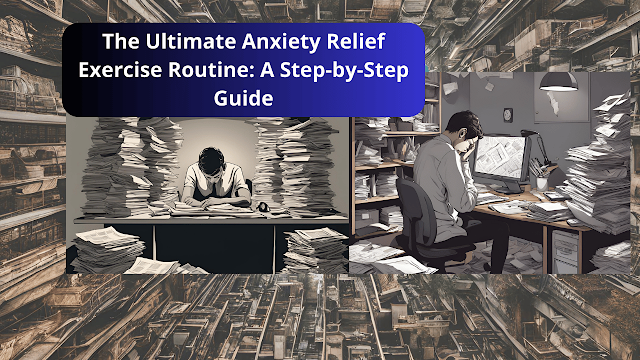The Ultimate Anxiety Relief Exercise Routine: A Step-by-Step Guide
Managing anxiety has become a growing concern in today’s fast-paced world. While therapy and medication can be effective, physical exercise is a natural and accessible way to reduce anxiety symptoms. A well-structured exercise routine can work wonders by boosting endorphins, improving sleep, and fostering a sense of control. Here, we present a scientifically-backed, step-by-step exercise routine designed to alleviate anxiety.
Why Exercise Helps with Anxiety
Exercise has profound effects on mental health. Engaging in physical activity stimulates the release of endorphins, often referred to as “happy hormones,” which can elevate mood and reduce stress. Moreover, exercise lowers levels of cortisol—a stress hormone—and promotes better sleep, which is crucial for managing anxiety.
Creating an Anxiety Relief Exercise Routine
Below is a simple and effective exercise plan tailored to reduce anxiety. The routine includes a mix of cardio, strength training, and relaxation techniques to provide comprehensive mental and physical benefits.
Day 1: Mindful Cardio
Duration: 30 minutes
1• Warm-Up (5 minutes): Start with light jogging or brisk walking to get your blood flowing.
2• Main Workout (20 minutes): Engage in moderate-intensity cardio, such as cycling, running, or swimming. Focus on your breathing and try to maintain a steady rhythm.
3• Cool Down (5 minutes): Walk slowly while practicing deep breathing to lower your heart rate.
Tip: Pair your cardio session with calming music or a podcast that lifts your spirits.
Day 2: Strength Training with a Twist
Duration: 30 minutes
1• Warm-Up (5 minutes): Perform dynamic stretches, such as arm swings and leg kicks.
2•Main Workout (20 minutes):
° Bodyweight squats (3 sets of 10-12 reps)
° Push-ups (3 sets of 8-10 reps)
° Dumbbell rows (3 sets of 10-12 reps on each side)
3• Cool Down (5 minutes): Stretch major muscle groups, holding each stretch for 15-30 seconds.
Tip: Focus on proper form and breathe deeply during each exercise to enhance the mind-body connection.
Day 3: Yoga for Stress Relief
Duration: 30 minutes
1• Warm-Up (5 minutes): Gentle neck rolls and seated breathing exercises.
2• Main Workout (20 minutes):
° Downward Dog (Hold for 30 seconds)
° Warrior II Pose (Hold for 30 seconds on each side)
° Child’s Pose (Hold for 1 minute)
° Savasana (Lie flat and focus on your breath for 5 minutes)
3• Cool Down (5 minutes): End with seated meditation or guided imagery.
Tip: Use a yoga mat and create a peaceful environment with soft lighting and soothing music.
Day 4: Active Recovery with Walking
Duration: 45 minutes
1• Choose a scenic route or park to walk at a comfortable pace.
2• Focus on your surroundings and practice mindfulness by engaging your senses—notice the colors, sounds, and smells around you.
Tip: Walking outdoors, especially in green spaces, has been shown to reduce anxiety levels significantly.
Day 5: High-Intensity Interval Training (HIIT)
Duration: 20 minutes
1• Warm-Up (5 minutes): Jumping jacks, high knees, and arm circles.
2• Main Workout (10 minutes): Alternate between 30 seconds of intense exercise and 30 seconds of rest. For example:
° Burpees
° Mountain Climbers
° Jump Squats
° Push-ups
3• Cool Down (5 minutes): Walk in place and stretch your muscles.
Tip: Keep the intensity at a level where you feel challenged but not overwhelmed.
Day 6: Pilates for Core Strength
Duration: 30 minutes
1• Warm-Up (5 minutes): Gentle stretches and spine roll-downs.
2•Main Workout (20 minutes):
° The Hundred
°°Roll-Ups
° Leg Circles
° Plank (Hold for 30-60 seconds)
3• Cool Down (5 minutes): Stretch your lower back and hamstrings.
Tip: Pilates strengthens the core, which can improve posture and reduce physical tension caused by anxiety.
Day 7: Rest and Reflection
Duration: 20 minutes
1• Practice deep breathing exercises or guided meditation for 10 minutes.
2• Reflect on your progress and journal about how the week’s activities have impacted your mood and anxiety levels.
Tip: Use this day to recharge and plan the week ahead.
Additional Tips for Success
Consistency is Key: Aim to stick to the routine for at least four weeks to see noticeable results.
Hydration and Nutrition: Drink plenty of water and consume a balanced diet to fuel your body.
Listen to Your Body: Modify exercises as needed to suit your fitness level and avoid injury.
Useful topics within the topic:
The best daily practical program to maintain mental health.
Conclusion: By incorporating this anxiety relief exercise routine into your lifestyle, you can create a powerful tool for managing stress and improving your mental well-being. Remember, small steps lead to big changes, so start today and prioritize your mental health.

.ico)

